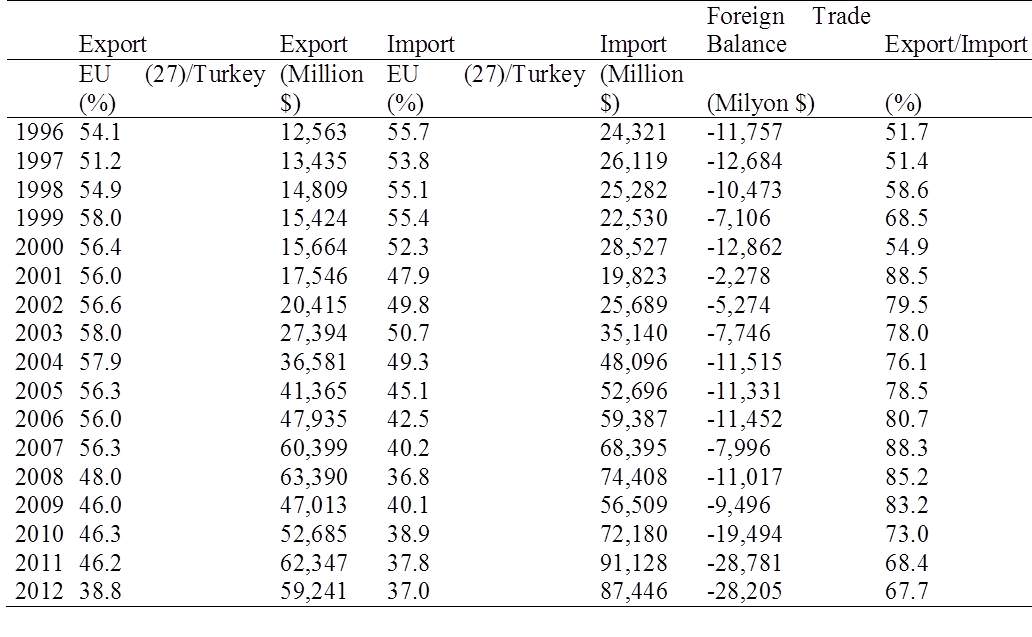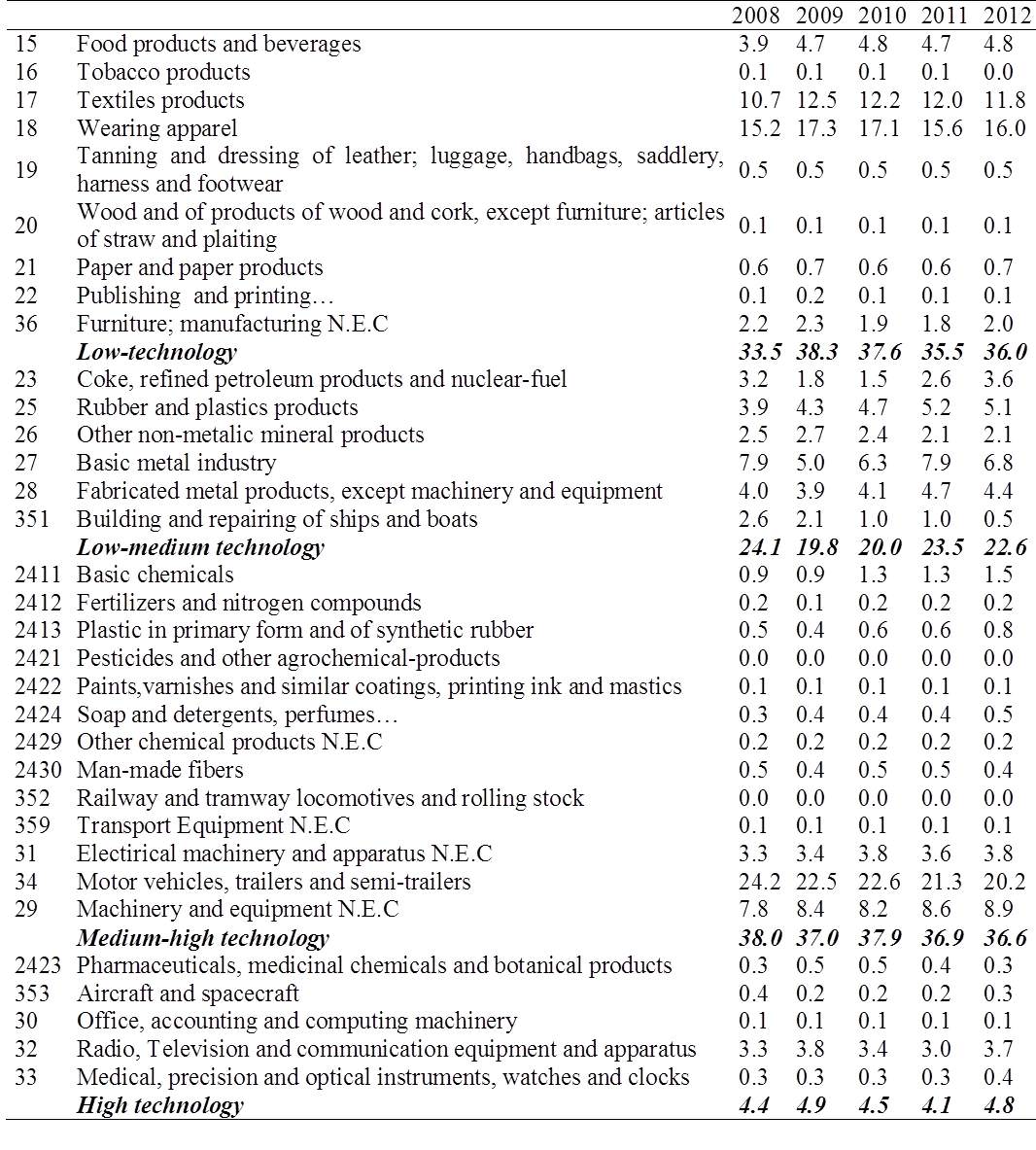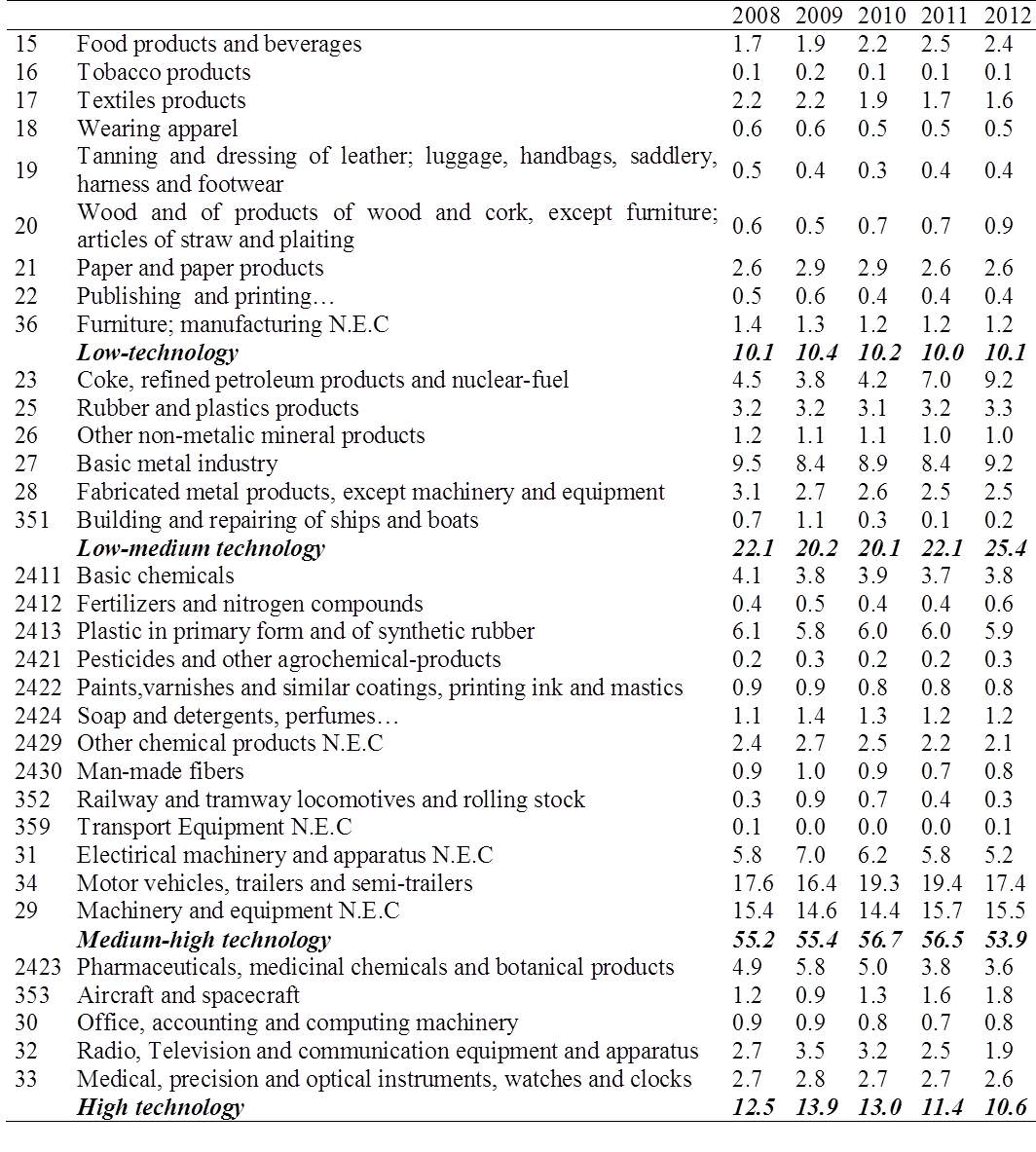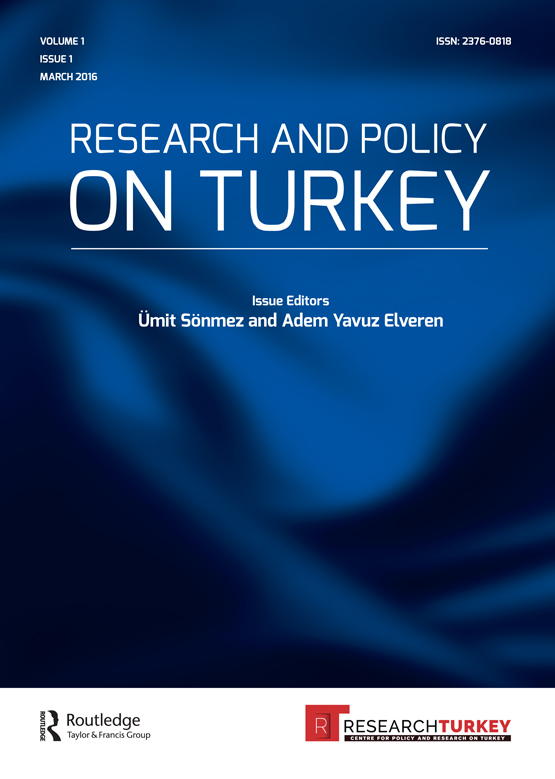Technological Structure of the Foreign Trade
between Turkey and the EU
Introduction
While Turkey was getting articulated to the world economy at the sectors the technological content of which was low within the frame of the model “export-oriented growth” in the early 1980’s, the policies implemented in the ensuring years remained limited at converting the technological level of the production and export, and consequently the technological level of the EU oriented export of Turkey developed basically based on the low and medium technologies. This essay aiming to investigate the technological structure of the foreign trade performed between Turkey and EU has been fictionalized under three parts. While the place of EU at the foreign trade of Turkey is examined in the first part, the topic of the second part is constituted by the technological structure of the foreign trade between Turkey and the EU, and the findings of the study are included in the third and final part.
1. The Place of EU in the Foreign Trade of Turkey
When Table 1 indicating the place of the EU at the foreign trade of Turkey is examined, according to both the parameters of export and import, it is seen that the relative importance of the EU at the foreign trade of Turkey started to get eroded considerably after 1996 when the customs union came into force. In 1996, it is understood that the import rate of EU-27 countries which is 55.7 % within the import of Turkey got considerably eroded in due course, and regressed to the rate 37 % in 2012, and that the export share Turkey carried out to EU-27 countries in the same period decreased from the rate 54.1 % to the rate 38.8 %. Due to the increasing export performed to the EU countries by Turkey more regularly than the import, at the commerce carried out with the EU, the rate of the export to meet the import increased from the rate 51.7 % to the rate 67.7 % in the period 1996 – 2012. In other words, while the export performed to EU-27 countries between 1996 – 2012 is increasing annually at the rate averagely 11.2 %, import has increased annually at the rate averagely 10.3 %, and consequently, the import coverage ratio of export has gone up considerably. When it is examined as the absolute values, while the export of Turkey performed to EU-27 countries was 12,563 million dollars in 1996 when the Customs Union entered in force, when it was 2012, it increased at the ratio of 372 %, and went up from 12,563 million dollars to 59,241 million dollars. Besides, import increased at the ratio 260 % in the same period, and went up from 24,321 million dollars to 87,446 million dollars.
When the development of the foreign trade carried out between Turkey and EU-27 countries is evaluated in general, it is understood that the increases which have occurred recently at the total import of Turkey haven’t been caused by the import performed from European Union, and that it has been caused by the countries outside the EU especially by the Asian countries (Eşiyok, 2012: 79). In other words, Customs Union prevents Turkey to use the rights of sovereignty over the customs, and it causes the Asian countries to cover the internal market of Turkey with the cheap cost goods and the increasing foreign trade deficits.

Source: It is constituted according to TÜİK data base.
2. Technological Structure of Foreign Trade
As it is known, the countries taking part in the centre of the EU are the ones which have the most developed technology of the world as of their structure of production, and it is seen that the countries constituting the core of the EU have carried out important progresses at technology as the result of industrial revolution they performed, and that they have constituted the biggest technological power together with USA and Japan. In this sense, revealing the technological level of the export performed to the EU countries by Turkey is extremely important in terms of indicating the quality of the international trade between Turkey and EU. The foreign trade theory professes that the rates of foreign trade in the mid and long period will develop as opposed to the first goods (Prebish, 1950; Singer, 1950), and the countries having this structure of production and export will have “Immiserizing Growth” as time passes ( Bhagwati, 1958:201-205 ).
2.1. Technological Structure of the Export
When Table 2 indicating the technological level of the export that Turkey has performed to EU is examined, it is seen that the export performed by Turkey to EU countries has developed basically based on the low profiled “low-mid technologies”, and the “high technology” export share has been limited. Accordingly, in 2012, the export share of the “low” and “high” technology included sectors representing the two ends has occurred as follows. Low technology (36.0 %), and high technology (4.8 %).

Source: Our own calculations based on OECD classification and TÜİK data base.
I understood that Turkey’s two traditional sectors (sectors of textile and wearing apparel) exist first before the leading sectors at the export of Turkey to European Union, and the total export share of these two sectors which was 25.9 % in 2008 has increased with time and gone up to the ratio 27.8%. Another traditional sector distinguishing beside the two traditional sectors including low technology is the sector of food products and beverages. The export share of the mentioned sector which was 3.9 % in 2008 increased with time and went up to 4.8 % in 2012.
Another basic category distinguishing at the export of Turkey to EU countries is the category consisting of the “low-mid technology” sectors. It is seen at the export performed by turkey to EU-27 countries that the export share of the low-mid technologies which was 24.1 % in 2008 was eroded with time and decreased to the ratio 22.6 % in 2012. The most basic sector within the low-mid technology export is constituted by the metal industry, and it is seen that the export share of the mentioned sector which was 7.9 % in 2008 decreased to the rate 6.8 % in 2012. Counter to the sectors including “low technology”, it is seen that there isn’t export concentration in the “low-mid technology” category, and that the export shares distribute amongst the sectors relatively as balanced.
It is determined at the export performed to European Union that the export share of the mid-high technology included sectors which was 38% in 2008 was eroded relatively with time and occurred at the ratio 36.6% in 2012. In this category, the basic sector is the sector of motor land vehicle, trailer and semitrailer, and it is determined that the export share of the mentioned sector which was 24.2% in 2008 remained still at a high level like 2.2 % in 2012, although it was eroded with time. Another important sector existing in this group is the sector manufacturing machine and equipment which isn’t classified anywhere else. The export share of the mentioned sector which had been 7.8 % in 2008 increased 1.1 point, and went up to 8.9 % in 2012. In other words, in the “mid-high technology” category, it has been determined that the export of Turkey to EU-27 countries has occurred basically at two sectors and mainly at the sector manufacturing motor land vehicle, trailer and semi-trailer. Amongst the sectors existing in this group, another sector which has the export share over 1 % is the sector of main chemical substances, and the export share of any other sector isn’t over 1%.
As a result, it is understood that the most basic categories at the export carried out by Turkey to EU-27 countries are constituted by the low, mid-high, and low-mid technology included sectors, and the export share of the high technology included sectors existing as leading one the technology content of which is the highest remained at the marginal level with 4.8 % as of 2012. Within the total export, being the export share of the low technology included sectors 36 % as of 2012, and the export share of the high technology included sectors 4.8 % indicates that the export structure of Turkey carried out to EU-27 countries basically consists of the low and mid-profiled sectors, and the foreign trade between these two structures has considerably differed qualitatively.
2.2 Technological Structure of Import
When Table 3 showing the sectoral import shares that Turkey has performed in EU-27 countries is examined in accordance with the technological level of Turkey, it is seen that the low technology included import share performed from EU-27 countries is about 10 %, and the two most basic importing sectors consist of the sector of food products and beverage and the sector of paper and paper products. In the import that Turkey has performed from EU-27 countries, it is seen that the import share of the sector of textile products which is one of the traditional sectors occurred at the level 1.6 % in 2012.

Source: Our own calculations through OECD classifications and TÜİK data base.
When the import shares of the low-mid technology including sectors are examined, it is seen that the import share of the mentioned sector group after 2012 occurred about 1/4, and the biggest support to the import performed in this group was given by the sectors of coking coal and refined petroleum products together with the main metal industry. The total import share of these two sectors as of 2012 has occurred at a relative high rate like 18.4 %.
It is seen that more than 50 % of the import Turkey performed from the EU-27 countries comprised of the sectors including the mid-high technology. It is understood that the two basic importer sectors are the sectors manufacturing motor land vehicle, trailer and semi-trailer and the sectors of machine and equipment which aren’t classified anywhere else. At the collocation of export share that Turkey have performed to EU-27 countries, the most basic leading one of the sectors is the sector manufacturing motor land vehicles and semi-trailer (as of 2012, the export share of the mentioned sector occurred at the ratio 20.2 %) (if it is considered that the mentioned sector is also importer considerably at the same time ), and it should especially be pointed out that the support of the sector to the foreign trade balance has remained limited.
At the import that Turkey carries out from EU-27 countries, the low technology included sectors and the high technology included sectors exist amongst the categories the export share of which is the smallest. As of 2012, the import share of the high technology included sectors that Turkey carries out from EU-27 countries is 10.6 %, and it is seen that the biggest support is the one performed by the sector of the chemical and herbal products which are used at pharmacy and medicine for this import, and that the mentioned sector is followed by the sector of medical, precision and optical instruments, watches and clocks with the import share 2.6 %.
2.3. Technological Structure of Foreign Trade Balance
According to the technology level, Table 4 that indicates the foreign trade balance (the sectors of net exporter and net importer) between Turkey and EU-27 countries is examined, it is seen that Turkey is the net exporter only at the low technology included sectors against EU but the net importer at the other three categories. The mid-high technology category is the leading one amongst the sectors in which Turkey is the net importer against the EU, and it is determined that the net import value of the mentioned sector group which had been 15,2 billion dollars in 2008 increased with time, and went up to 22,8 billion dollars in 2012. While Turkey had been the net exporter in 2008 with 13,2 billion amongst the low technology included sectors, the value of net export value decreased to 12,1 billion dollars when it was 2012.

Source: Our own calculations.
Consequently, the relation of foreign trade between Turkey and EU looks like the foreign trade relation between a typical metropolitan-environment country, and while Turkey is the net importer at the sectors the technology content of which is high (at the sectors being dependant on abroad), it seems it is the net exporter at the low technology included sectors in which the local production support is high.
3. Conclusion
When the technological profile of the foreign trade between Turkey and EU is investigated, it is understood that the most basic category at the export performed by Turkey to EU countries is constituted by the “low” and mid-low” technology included sectors. According to the findings of 2012, while the exports share of the low technologies occurred at the ratio 36.0 %, and the export share of the mid-low technologies was determined at the ratio 36.6 %. On the other hand, it is seen that the high technology export share of Turkey has remained limited with 4.8 %. When the technological profile of the import that Turkey performed from EU countries, it is understood that it has developed based basically on the mid-high technologies, and the import share of the mentioned category occurred at a high level like 53.8 % as of 2012. Contrary to the export carried out to EU, the share of the low technologies at import is considered extremely low, and it is seen that it constituted the smallest category in 2012 with the import share 10.1 %. No doubt, this result is an outgrowth of the foreign trade profile of a developing economy like Turkey that has mainly specialized at the low and mid technology included sectors and the EU countries that have the production structure based on high technology.
The export increase of Turkey to the EU countries in the following years will be considerably concerned with the developments it will provide at technology. In other words, it seems that Turkey’s being the net exporter at the relatively high sector with the technology content through it has had foreign trade deficit depends on the transformations that production industry will perform at the structure of production. Besides, it is clear that a transformation from the sectors providing low added value to the sectors providing high added value depends on only a new approach which puts the technology policies on an industrialization strategy that will get prepared and on the centre of this strategy.
B. Ali Eşiyok, Senior Economist, Development Bank of Turkey
Please cite this publication as follows:
Eşiyok, B. Ali (August, 2013), “Technological Structure of the Foreign Trade between Turkey and the EU”, Vol. II, Issue 6, pp.54-60, Centre for Policy and Research on Turkey (ResearchTurkey), London, Research Turkey. (http://researchturkey.org/dev/?p=3980)
References
Bhagwati, Jagdish; (1958), “Immiserizing Growth: A Geometrical Note”, Review of Economic Studies, June , s. 201-205.
Eşiyok, B.Ali; (2012), “Türkiye Ekonomisinde Cari Açık Sorunu ve Nedenleri”, Finans Politik & Ekonomik Yorumlar, Sayı: 569, s.63-86.
OECD (2011), ISIC Rev.3 Technology Intensity Definition, OECD Directorate for Science, Technology and Industry, Economic Analysis and Statistic Division.
Perebisch, Raul; (1950), “The Economic Development of Latin American and Its Principal Problems” (Lake Success, NY: United Nations, Depertmant of Economic Affairs), Reprinted in Economic Bulletin for Latin America, 7(1962), p:1-22.
Singer, Hans W; (1950), “The Distribution of Gains between Investing and Borrowing Countries”, The American Economic Review, Volume 40, pp.473-485.
www.tuik.gov.tr




Araştırmacının bulguları son derece ilginç. Teknolojideki açmazları başarılı bir şekilde ortaya koymuş. Bu bulgular göz önüne alındığında yeni bir sanayileşme politikası kaçınılmaz gözüküyor
makalenizi baz alarak sunum yaptım. teşekkürlerimi iletiyorum